Bass consistently strike proven lure categories that match their feeding behavior and seasonal patterns. You’ll find success with Yamamoto Senkos for their natural horizontal fall, versatile grubs rigged multiple ways, drop shot setups that suspend bait naturally, topwater frogs for explosive surface strikes, crankbaits targeting mid-water columns, and realistic swimbaits mimicking baitfish. Color selection depends on water clarity, with natural tones for clear water and chartreuse or black for stained conditions. Understanding these fundamentals will reveal advanced techniques for consistent bass success.
TLDR
- Yamamoto Senko excels with its natural horizontal fall and shimmy action that effectively mimics dying baitfish in pressured waters.
- Swimbaits offer high hookup rates due to realistic baitfish appearance and soft bodies that bass can fully ingest.
- Topwater frogs trigger explosive strikes when retrieved with slow, deliberate twitching across vegetation and thick cover areas.
- Crankbaits effectively target suspended bass in mid-water columns when matched to local baitfish depth, color, and profile.
- Drop shot rigs suspend bait above bottom structure for natural presentation, ideal for finesse fishing in clear water conditions.
Yamamoto Senko: The Ultimate Soft Plastic for Year-Round Success
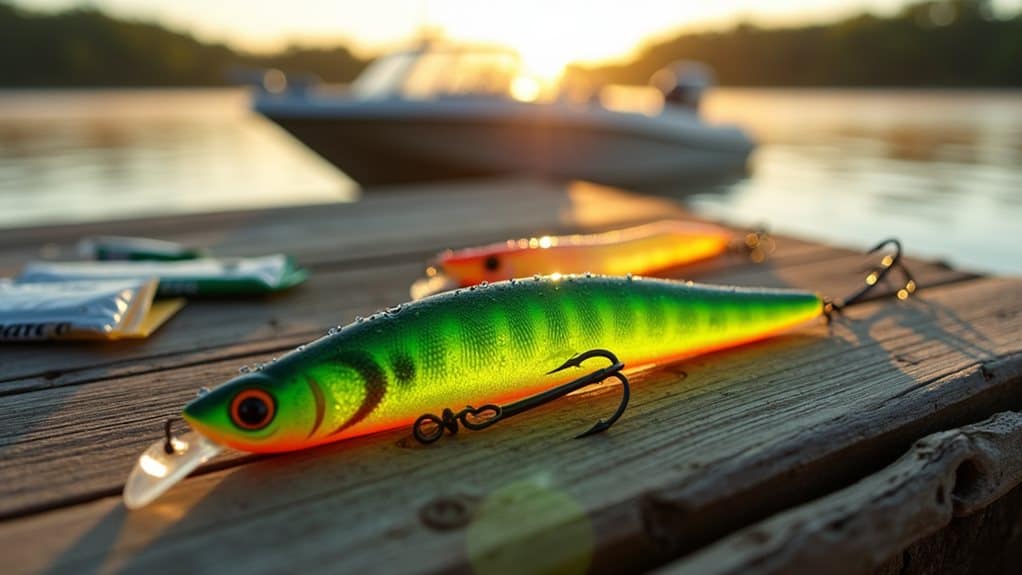
When it comes to soft plastic lures that consistently produce bass year after year, the Yamamoto Senko stands in a class of its own.
You’ll find this simple stick worm’s natural horizontal fall and subtle shimmy perfectly mimics dying baitfish, triggering strikes from pressured bass. Alamo Lake, known for its exceptional bass fishing, is an ideal location to put this lure to the test.
Its salt-loaded formulation provides excellent casting distance while encouraging fish to hold on longer. The Senko’s deceptive simplicity makes it effective across multiple presentation styles, from precise flipping around docks to cast-and-retrieve techniques in open water.
Versatile Soft Plastics: From Grubs to Drop Shot Rigs
You’ll find that dominating grub rigging techniques opens up countless opportunities to trigger reaction strikes from bass at various depths and cover types. The key lies in understanding how different rigging methods affect the bait’s action, whether you’re bouncing a grub on a jighead through rocky structure or swimming it steadily through open water. In addition, utilizing a fish finder can help you identify the best locations to target bass effectively. Setting up a proper drop shot rig requires attention to detail in hook placement and weight selection, but once you’ve got it dialed in, you’ll have one of the most effective finesse presentations for pressured or clear-water bass. While grubs have been less utilized recently in modern bass fishing, they remain highly effective when rigged on spinnerbaits, Carolina rigs, and jigheads for targeting both active and finicky fish.
Grub Rigging Techniques
Grubs rank among the most versatile soft plastic baits in any bass angler’s arsenal, offering multiple rigging options that adapt to virtually any fishing situation you’ll encounter on the water.
You’ll find success using round ball or darter jigheads for open water, Texas rigging for heavy cover, weightless setups for finesse presentations, and Carolina rigs for bottom structure fishing.
Drop Shot Setup
The drop shot rig takes soft plastic versatility to another level by suspending your bait several inches above the lake bottom, creating a natural presentation that’s anchored by a weight below the hook.
You’ll typically use finesse worms, creature baits, or stick baits nose-hooked on this setup, allowing them to hover and dance with subtle rod movements.
Stickbaits and Jerkbaits: Covering Water With Realistic Baitfish Action
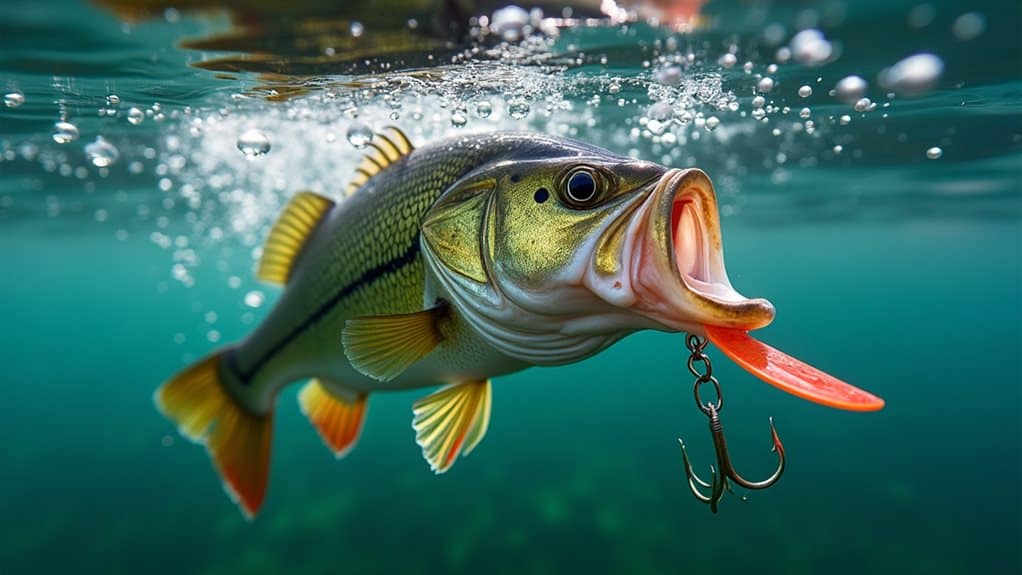
Nothing quite matches the excitement of watching a bass explode on a jerkbait during that critical pause, and these versatile lures excel at covering water while providing the realistic baitfish action that triggers aggressive strikes.
You’ll find stickbaits particularly effective in cooler water at depths of 5-12 feet, where their suspending action mimics wounded baitfish perfectly. Additionally, employing weightless Texas-style rigging can enhance your presentation and increase your chances of enticing strikes.
Spinnerbaits: Flash and Vibration for Heavy Cover Situations
Few bass lures can match the spinnerbait’s ability to penetrate heavy cover while providing the irresistible combination of flash and vibration that triggers aggressive strikes from pressured fish.
You’ll want Colorado blades for murky water situations, creating strong vibration that bass detect through their lateral line.
Slow-roll through vegetation, letting the bait tick cover tops without snagging. An effective setup can be enhanced by using a rod and reel combo that simplifies selection and reduces the risk of mismatched equipment.
Topwater Frogs: Explosive Surface Strikes in Shallow Water
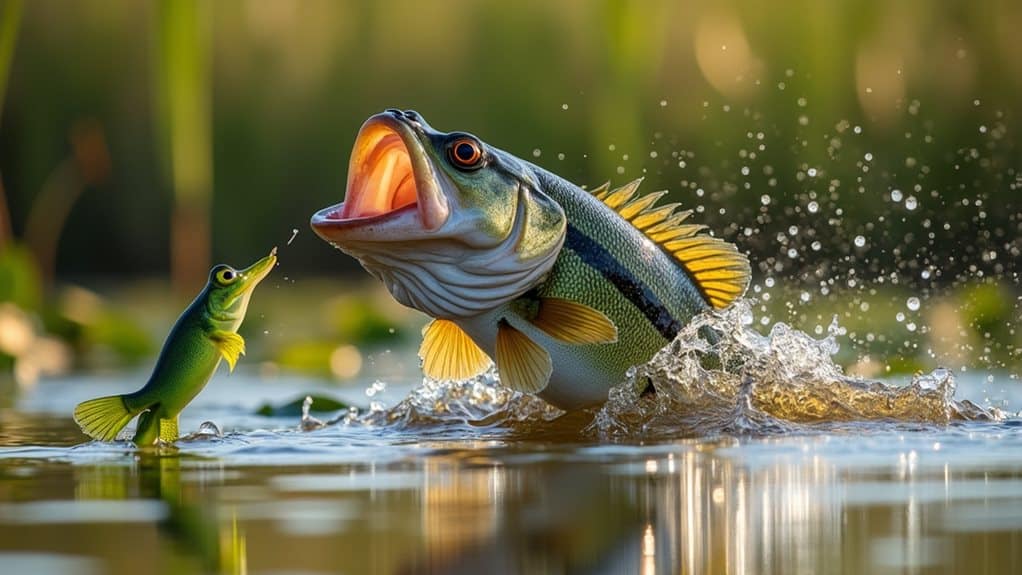
When you’re fishing topwater frogs, your retrieval technique can make the difference between explosive strikes and missed opportunities in shallow water.
The key lies in working your frog slowly across lily pads and grass mats with deliberate twitching motions that create just enough surface disturbance to trigger aggressive bass responses.
You’ll find the most success by targeting specific locations where bass ambush prey—areas with thick vegetation mats that have clear pockets and hunting lanes underneath.
Best Frog Retrieval Techniques
Three fundamental elements separate effective frog retrieval from random casting: speed variation, precise timing, and strategic positioning.
You’ll want to frequently change your cadence—slow, intermittent twitches across grass mats entice cautious bass, while faster retrieves through open water trigger aggressive strikes.
When you miss a strike, immediately re-cast to the same spot for another opportunity.
Prime Topwater Fishing Locations
While many anglers focus solely on lure selection and retrieval techniques, the locations you choose for topwater frog fishing often determine whether you’ll experience explosive surface strikes or spend hours casting without results.
Target shallow water areas with lily pads, hydrilla mats, and emergent vegetation edges where bass ambush prey from cover beneath the surface.
Jigs and Creature Baits: Bottom-Dwelling Prey Imitations
Since bass spend considerable time foraging along lake and river bottoms, jigs and creature baits represent two of the most effective lure categories for consistently triggering strikes from these predators.
These lures excel at imitating crawfish and bottom-dwelling creatures through realistic appendages that create lifelike kicking actions, making them irresistible to hungry bass.
Crankbaits: Diving Deep for Mid-Water Bass
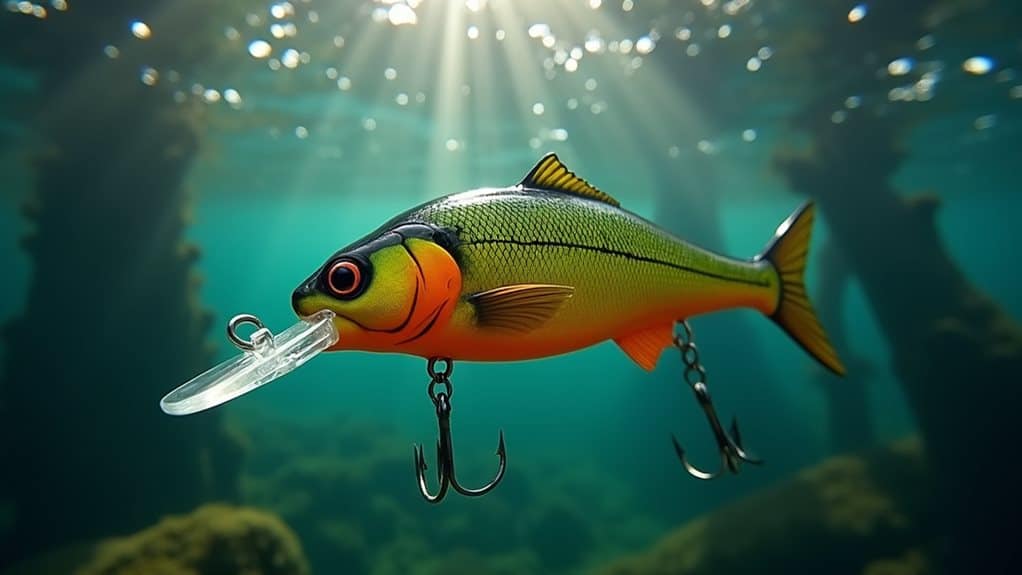
When you’re targeting bass suspended in mid-water columns, crankbaits become your primary weapon for reaching those specific depth zones where fish are actively feeding.
Your success depends on three critical factors: selecting the right depth range to match where bass are positioned, choosing colors and profiles that mimic the local baitfish they’re hunting, and varying your retrieval speeds to trigger strikes from both aggressive and neutral fish.
Perfecting these elements changes crankbait fishing from random casting into a precise, systematic approach that consistently puts bass in the boat.
Depth Range Selection
As you venture into deeper waters targeting mid-water bass, understanding crankbait depth ranges becomes essential for consistent success.
Deep diving crankbaits typically reach depths from a few feet to 20+ feet below the surface.
You’ll want to select a crankbait that runs slightly deeper than your target water depth, ensuring the lure contacts bottom structure and triggers reactive strikes.
Color and Profile Matching
Once you’ve matched your crankbait’s running depth to the target zone, selecting the right color and profile becomes your next strategic decision for fooling mid-water bass.
In clear water, choose natural shad patterns with silver and white tones.
Murky conditions call for bright chartreuse or orange colors that cut through limited visibility and trigger aggressive strikes.
Retrieval Speed Techniques
Becoming proficient in your retrieval speed alters an ordinary crankbait presentation into a strike-triggering weapon that adapts to bass behavior throughout the day.
Fast, steady retrieves provoke reaction strikes from aggressive bass, while slower speeds work better during cold fronts or colder water.
Frequently changing your retrieve speed—speeding up, slowing down, adding pauses—helps you locate the bass’s mood and triggers more strikes.
Swimbaits: Lifelike Baitfish Presentations
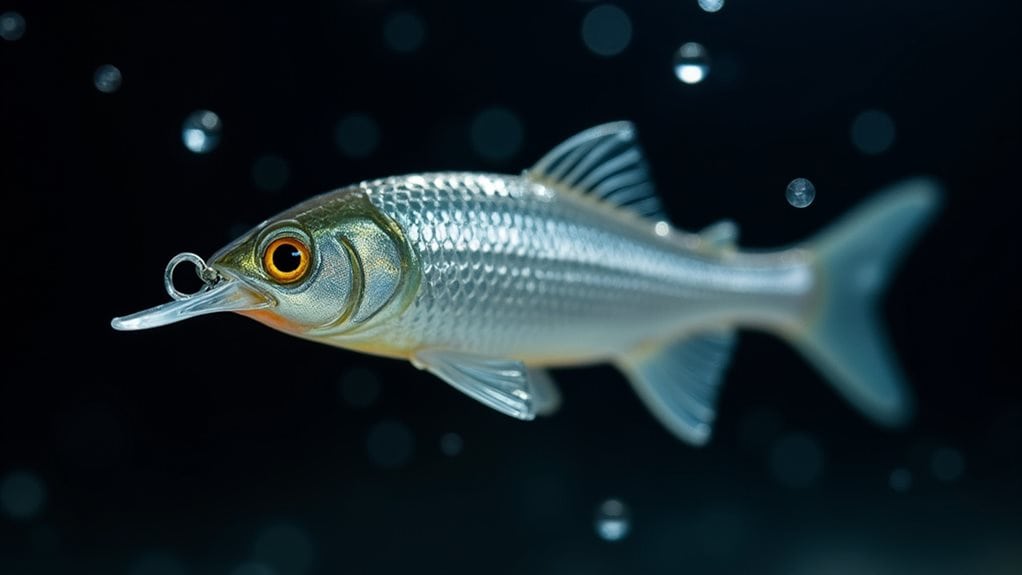
The swimbait stands as one of the most effective bass lures available to anglers, combining realistic appearance with natural swimming action that closely mimics the baitfish bass feed on daily.
You’ll find their soft bodies fold easily when bass strike, allowing full ingestion and higher hookup rates.
These versatile lures work at multiple depths year-round.
Color Selection Strategies for Different Water Conditions
Five critical factors determine which colors will trigger strikes from bass in any given fishing scenario, with water clarity serving as your primary guide for making the right choice.
In clear water, you’ll want natural colors like silver, grey, or brown.
Stained water calls for chartreuse or black, while depth changes require adjusting contrast accordingly.
Seasonal Lure Patterns: Matching Bass Behavior Throughout the Year
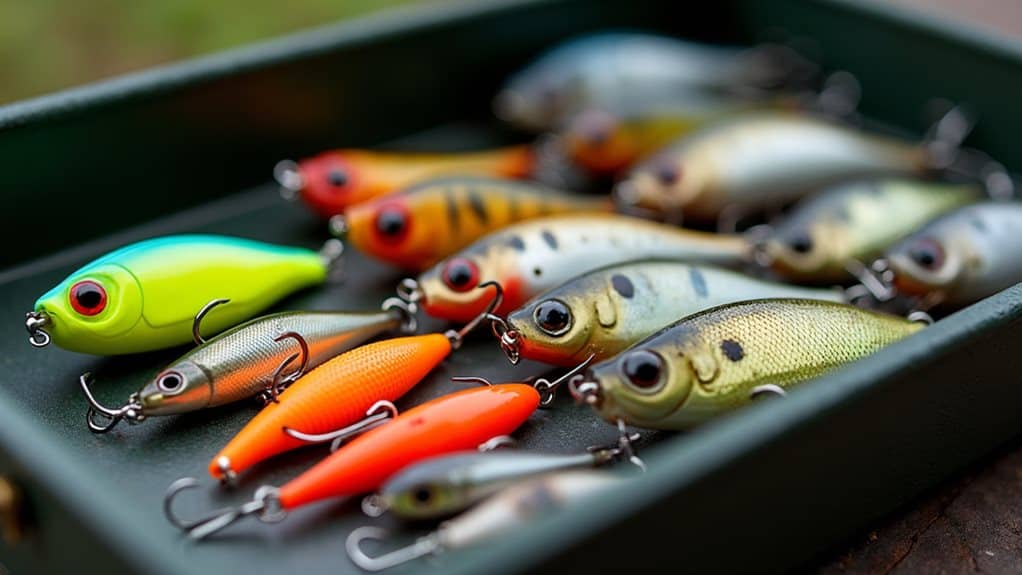
As water temperatures shift throughout the year, bass behavior changes dramatically, and your lure selection must adapt accordingly to maintain consistent success on the water.
Spring bass stage at 8-15 feet using crankbaits and jigs.
Summer requires slow presentations like Texas rigs in deeper water.
Fall triggers aggressive feeding with topwater lures, while winter demands patient finesse techniques.
Final Note
You’ll catch more bass by matching your lure selection to specific conditions and seasons. Start with versatile options like Senko worms and spinnerbaits, then expand your arsenal based on your local waters. Remember, color matters in different clarity levels, and seasonal patterns dictate bass behavior. Don’t overthink it—confidence in your chosen lure often trumps perfect selection. Practice with these proven options, and you’ll develop the instincts needed for consistent bass fishing success.




